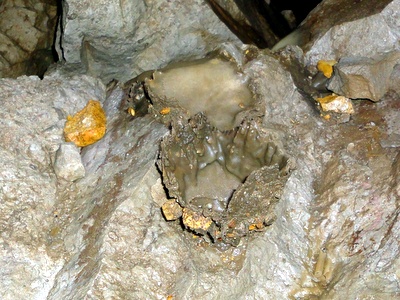For those who haven’t yet had the pleasure of descending Shuttleworth Pot, it is a short pothole on Leck Fell that finishes in the 20 metre Diver’s Pitch, which drops into Witches II Cave in a large chamber. To the north a steep slope descends to a short section of river passage with the sump to Witch’s Cave downstream, and the sump to Pippikin upstream. To the south of Diver’s Pitch a slope ascends to a short flat-out crawl which emerges at the active Balcony Aven. Ahead and below, the main passage continues upstream as a well decorated canyon passage, Painter’s Alley, with a misfit stream. This terminates in a short boulder ruckle above which is a large chamber, with Dogger Bank ascending steeply to the left finishing in a blank wall, whilst ahead a canyon passage rises steeply past an impressive forest of straws to an aven complex – Oxbow Aven. The main passage continues over the sump area as the Exercise Yard, which finishes in a mud choke.

The Calcite Cup in Witches II
Photograph: Anthony Brown. Date: July 2011
Click on the image to see a larger photograph.
By now, many club members will have descended Shuttleworth Pot and admired the array of formations that adorn Witches II Cave. The virtues of many of them are obvious: the forest of two metre long straws below Dogger Bank which is unsurpassed in the Dales; the beautiful bronze stalagmite at the top of Painter’s Alley; and the fragile volcanoes, so close to the path, are but examples of what await the visitor.
There is, however, one small, fairly innocuous formation which tends to go unnoticed. It is a calcite cup which may be found midway between the climb up through the boulders beyond Painter’s Alley, and the path up Dogger Bank. It isn’t much to look at. It’s about 10 cm high, and sits on a boulder which is bare apart from a smattering of yellow gravel, a small white calcite flow, and some protective tape. But this cup is of particular interest, as it reflects a great deal of the history of the cave.
The logical place to start the story is to consider the void in which the boulder sits – close to the base of a large phreatic passage which at this point has been enlarged by collapse. Flow markings in the passage indicate that the most recent phreatic flow was from south to north, although wiser heads than mine believe that it may previously have flowed in the other direction. This passage continues to the north over the sump to the Exercise Yard, but whether its origin was from a passage blocked by sediment behind Dogger Bank, or from the Oxbow Aven complex is unclear. It is almost certainly a fragment of a pre-Devensian phreatic trunk route which drained Leck Fell to an unknown resurgence in Ease Gill.
Much of Witches II is dominated by a four metre wide fracture zone which can be seen to best advantage in the area below the Diver’s Pitch. The boulder forming the pedestal for the calcite cup has fallen from the roof which is within this fracture zone. It is possible that the fall occurred as a result of the passage draining, removing the support of the water, but what is certain is that some time after the boulder fell there was a distinct change in flow conditions during which the floor became covered with a thick layer of sediment which completely covered the boulder. The extent of these sediments may be seen a little further up the passage, where a four metre high wall of varved deposits have been exposed, as well as in the canyon at the bottom of Painter’s Alley where they have also been cut through. It can also be seen to have almost filled the whole passage beyond Balcony Aven where cavers pass through the flat-out crawl towards the base of Diver’s Pitch. This will have happened before the last ice age.
Some time later, the passage completely drained, and a drip from high in the roof gradually formed a hole in the sediment covering the boulder, depositing a thin film of calcite on the inside. The same process is currently being enacted on a mud bank at the top of Painter’s Alley. We don’t know the original depth of the mud, as only the base of the drip hole has been preserved but those still being formed are as much as 30 cm deep.
Flow conditions once again changed, and a different stream took advantage of the existing passage. Base levels had fallen by this stage, presumably as a result of the most recent glaciation modifying the landscape, and this stream truncated the sediments at the bottom of Dogger Bank, and carved out the canyon through the older sediments in Painters Alley, before sinking in the floor below Balcony Aven. Its course can be traced by thin deposits of yellow gravel which it left behind. These may be found on the remains of false floors high up the walls near Oxbow Aven, and on ledges on the eroded mud banks in Painter’s Alley. The new stream washed away the old sediment which covered our boulder, leaving behind the calcite cup as a relict, together with a few fragments of the tell-tale yellow gravel.
This stream has long disappeared, and the boulder is once more exposed to drips from the roof. There is no longer any mud, however, and so a layer of white calcite flow is now spreading across the boulder. With good fortune, this process will continue, but the next stage in the calcite cup’s history may well be its destruction by clumsy hands.


